Chihuahua
by Don Bailey from Don Bailey, State and Federal Copper And Brass Coinage Of Mexico (1824 – 1872), Don Bailey Institute for Mexican Numismatic & Historical research, 2008
The Chihuahua Mint, after having been closed since 1822, resumed operations in 1832. The mint operated with many difficulties and losses, so it was leased. Operators found a good alternative to minting silver to make a profit, thanks to the minting of copper coins which, due to their minting costs compared to their face value, were an attractive option. The Chihuahua mint issued coppers off and on from 1833 to 1866.
José Manuel SobrinoSobrino, José Manuel, La Moneda Mexicana, Su Historia.1972, Banco de México. México D.F writes: "By decree of 17 August 1832[text needed], the minting of fifty thousand pesos in copper cuartillas and octavos with the same design was authorized, since they differed only in diameter." The number of coins minted was higher than authorized and for a time they were valid only in the state of Chihuahua itself.
Standing Indian
The standing Indian style was struck from 1833 to 1856. The obverse has an Indian standing, holding a bow and arrow, with a quiver across his back (the significance of the use of this image is discussed here). On some issues the Indian's quiver has a cross belt. However most show such wear that this belt may not be visible. The obverse inscription changed with the political conditions. The reverse has contained in a wreath the denomination and date. Both denominations of the 1833 have a fine wreath with the inside trimmed. The 1834 and 1835 of both denominations have a coarser wreath without the inside cropping of the 1833. The 1835/3 utilizes the earlier wreath. The edges of these issues after 1835 are plain.
⅛ real
The ⅛ real was issued in 1833, 1834, and 1835 with the legend, "ESTADO SOBERANO DE CHIHUAHUA", and in 1855 with the legend "ESTADO DE CHIHUAHUA".
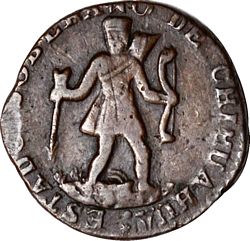
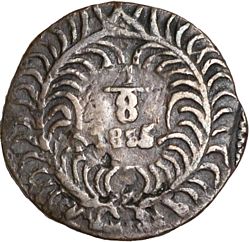
KM 318 ⅛r 1835/3 Chihuahua (Stack’s Bowers Baltimore auction, 20 November 2012, lot 11278)
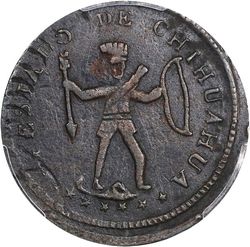
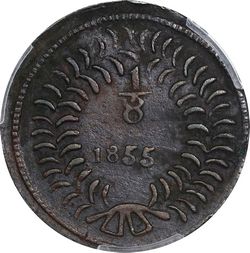
KM 319 ⅛r 1855 Chihuahua (Stack’s Bowers Baltimore auction, 31 August 2023, lot 70303)
| KM 318a | ESTADO SOBERANO DE CHIHUAHUA | 1833 | 20mm | fine wreath |
| KM 318b | 1834 | coarse wreath | ||
| KM 318b | 1835 | coarse wreath | ||
| KM 318a | 1835/3 | fine wreath | ||
| KM 319 | ESTADO DE CHIHUAHUA | 1855 | 20mm |
¼ real
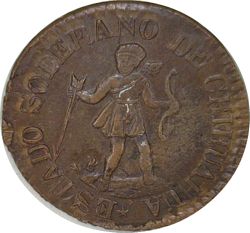
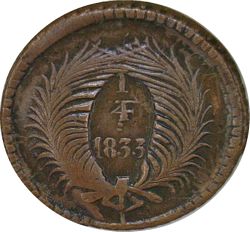
KM 340 ¼r 1833
The ¼ real was struck in 1833 through to 1835 with the legend, "ESTADO SOBERANO DE CHIHUAHUA", and in 1846 with the legend, "ESTADO LIBRE DE CHIHUAHUA".
The 1846 ¼ real, thought by Pradeau to be a false issue produced in Allegheny, Pennsylvania U.S.A. in 1860Pradeau, [ ]. Luna Herrera adds: “Recent research suggests that the 1846 coin is counterfeit, having been minted in Chicago, United States, during the U.S. intervention in Mexico, and introduced into the country to defraud Mexicans and defray expenses. Other sources agree, adding that the 1846 coin was made in New Mexico in 1860. The difference is the edge, as the counterfeit coin does not have the fluted, edge, like the coinage of the time, and the planchet is slightly smaller (Pablo Luna Herrera, https://eldatonumismatico.wordpress.com), is more likely to have been produced in both countries. It is not likely that a counterfeit would be created without an idea of an existing circulating model nor is it plausible that a new legend would be created just for a false issue. The very large number of die varieties and styles would also argue against a pure counterfeit. The star at the bottom of the legend is most often found to be five- pointed. A circle usually surrounds the five-pointed star except on the 'D over reversed D' variety[image needed].
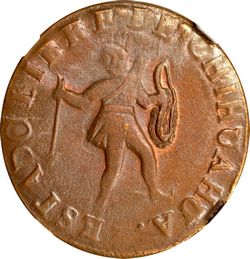
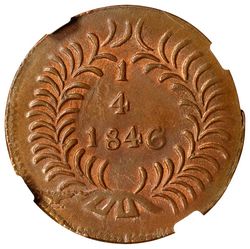
KM 341 ¼r 1846 variety without fraction bar (Stack’s Bowers NYINC auction, 15 January 2022, lot 2318)
Some pieces of this 1846 coin were minted without the fractional bar in the denomination "¼".

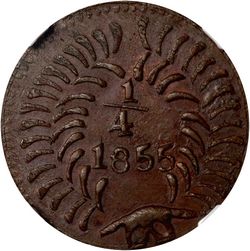
KM 342 ¼r 1855 Chihuahua DEPARTAMENTO (Stack’s Bowers auction, 23 February 2022, lot 74734)
The legend, "DEPARTAMENTO DE CHIHUAHUA" was used in 1855.
Die orientations are generally medal ↑↑ until the issue of the seated Liberty type of 1860 when coin orientations ↑↓ were used. The 1846 cuartilla generally conforms to this although an irregularity is found with the missing fraction bar variety. Here, both medal and coin orientations are encountered.
The herringbone pattern edge used on the 1833-35 types are most often incomplete or even missing, especially on irregular planchets. Thin planchets usually have incomplete legends but some traces will likely be found. The herringbone edge seems to have been attempted on the octavo but weakly at best.
| KM 340a | ESTADO SOBERANO DE CHIHUAHUA | 1833 | 27mm | fine wreath |
| KM 340b | 1834 | coarse wreath | ||
| KM 340b | 1835 | coarse wreath | ||
| KM 340a | 1835/33 | fine wreath | ||
| KM 341 | ESTADO LIBRE DE CHIHUAHUA | 1846 | 26mm | with fractional bar |
| KM 341a | 1846 | w/o fractional bar | ||
| KM 341b | 1846 | D over reversed D | ||
| KM 342 | 1855 | 26mm | ||
| KM 342 | 1856 | |||
| KM 343 | DEPARTAMENTO DE CHIHUAHUA | 1855 | 24mm | |
| 1855 | D over reverse D |
Seated Liberty
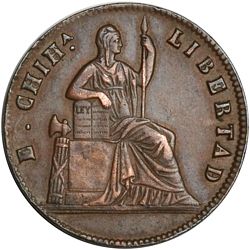
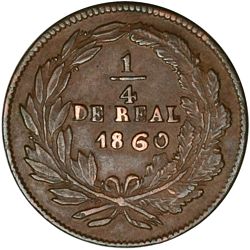
(KM 344 ¼r 1860 Chihuahua (Stack’s Bowers Baltimore auction, 28 March 2011, lot 8071)
In 1860 a new design was introduced, when on 20 January 1860[text needed] the state governor, José Eligio Muñoz, ordered that the seated Liberty ¼ real coins be struck. The obverse has a figure of Liberty seated holding a spear, leaning upon the tablets of the law, with the inscription, "E. CHIHA. LIBERTAD". The reverse has the denomination, and date, from 1861 through 1865. This design was probably influenced by the design of the ⅛ real coins issued by the Mexico mint.
In 1860 the then Governor of Chihuahua (for a mere nine months), José Elijio Muñoz, listened to the complaints from citizens, merchants and bureaucrats alike and issued state bonds for the exchange of damaged or overly circulated coins. When Luis Terrazas took over the Chihuahua government, he decided to make an issue of 200,000 pesos to exchange those defaced coins instead of Muñoz’s proposed bonds. This new copper issue would avoid the endless accounting and printing inherent in official paperwork, but the decree came at the end of 1860, so the complete 200,000 pesos budget extended into 1861.
Benito Juárez’ coinagefrom Ricardo de León Tallavas, "The Intriguing 1868 Chihuahua Copper Coin Bonds of Exchange" in USMexNA journal, March 2023
No copper coinage happened during the three-year period from 1862 to 1864. However, this was about to change out of a circumstance no one could have foreseen in 1860: an international invasion. President Benito Juárez had had to relocate as he was being persecuted by the Imperial French armies throughout the Mexican territory. These military skirmishes drove Juárez to the northern state of Chihuahua on 29 September 1864, and he entered the capital city of Chihuahua on 12 October of that year. Juárez stayed there until 18 December 1866, Chihuahua being the place that he stayed the longest outside of Mexico City. However, it is not cheap to sustain any federal government in any place in geography or history. Chihuahua’s citizens were soon to find out this concrete fact.
To face the enormous expenses of Juárez’s government, three months after his establishment, the President of Mexico decreed a compulsory loan of copper coins to be issued “without the required bond”. The “bond” was an equal amount of silver meant to back up any municipal or statewide issue for the time when it was to be redeemed. This Juárez’s copper issue was a completely fiduciary issue and without any possibility of conversion into silver from the very minute these coins were conceived on paper. Luis Terrazas, the Governor of Chihuahua, authorized 60,000 pesos on 1 January 1865, being entirely equal in design, weight and size as those dated in 1860-61. This amount was extended by an additional 40,000 pesos on 7 March and finally by an extra tranche of another 60,000 pesos. The complete sum finally agreed was 160,000 pesos in unbonded cuartillas (5.12 million coins). The last decree in its second article explained that this compulsory loan was vital and that it would be covered by the federal government. This decree was signed by Juárez, endorsed by Terrazas and a copy sent to the Secretary of the Ministry of Development and another to the Ministry of the Tax Revenue and Public Credit. Copper coins dated in 1865 and 1866 were easy to recognize and all of them were explicitly the core of this loan, distinct from the rest of the coins in public circulationDiccionario de la legislación mexicana: que comprende las leyes, decretos, bandos, reglamentos, circulares y providencias del supremo gobierno y otras autoridades de la nación, publicados desde el 31 de mayo de 1863 hasta el 31 de diciembre de 1871, “La Constitución social”, Mexico City, 868, pp. 495. 498.
On the 1860 cuartilla and others, the E (for Estado) is sometimes filled, resembling an H. There are many degrees of this from partially to completely filled. The 1865 issue sometimes listed as 1865/1 is not an over date but the result of shallow punches used to date the hub. There is no trace of a serif, which is very prominent on the final 1 of the 1861 coin. The so-called 1866/5 appears to be blundered punch work.
| KM 344 | E. CHIHA. LIBERTAD | 1860 | 28mm | |
| 1860 | Error ‘H’ instead of ‘E’ in ‘E. CHIHA’ | |||
| 1861 | ||||
| 1865 | ||||
| 1866 |
Amortization
Once the Republic was permanently established in Mexico City, on 15 July 1867, with Juárez in charge, things started to happen very quickly. The main focuses of this government were on three fronts: political, military, and economical. Possibly at the beginning or middle of May 1868, the newly re-elected governor Terrazas instructed a Chihuahua senator to remind Juárez about the outstanding loan. One way or another, Juárez did not wait for Congress to meet. He began the payment of this compulsory loan to Chihuahua’s Treasury on 23 May 1868 with a single article that addressed this debt, being endorsed by the Mexican Senate six days later. The legal mechanism for the National Treasury to pay this loan had started. The way planned for this payment was in the form of bonds to the bearer, to be issued in Chihuahua. The only problem is that in all these decrees it was stated as “100,000 pesos” the total owed by Juárez to Chihuahua. These bonds would be used as cash for any federal tax or imports, exports, etc., but just up to five pesos. If the amount owed exceeded five pesos, these bonds would be taken for 75% of the debt, with the rest due in hard cash, by the Federal Offices throughout the state of ChihuahuaMemoria de Hacienda y Crédito Público, correspondiente al cuadragésimo quinto año económico…, op, cit, pp. 627, 672 and 768.
A month later, on 20 August, a Regulation was issued by the government to define these bonds in great detail. An official reviewing committee would be formed by two official representatives and two civilians. It was commanded that each and all cuartillas recovered by this method were melted into bars and then recycled into Republican centavos. This new centavo coinage never happened in Chihuahua for an unknown reason. Again, just 100,000 pesos were mentioned as a total debt. This regulation was signed by J. M. Garmendia as First Officer in Mexico City.
On 18 September 1868 Chihuahua started to plan the distribution of these bonds between the cantones. On that same date, but in Mexico City, the bonds were agreed to be printed by the Federal Government, using two colors of ink on each series, and now for the complete amount of 160,000 pesos. The extra 625 pesos was mentioned to cover expenses for printing, shipping, and acquiring the copper cuartillas by the federal offices. Finally, these bonds were dated on 31 October 1868 at Mexico City, and bear the printed signatures of Matías Romero, as the National Secretary of the Office of Revenue and Public Credit, and the distinguished Campeche politician, Manuel P. Izaguirre, as National Treasurer.
| Denomination | Series | from | to | Number of bonds | Total |
| 100 pesos | 1 A | 1 | 700 | 700 | $ 70,000 |
| 50 pesos | 2 B | 701 | 1500 | 800 | 40,000 |
| 20 pesos | 3 C | 1501 | 2250 | 750 | 15.000 |
| 10 pesos | 4 D | 2251 | 3750 | 1,500 | 15,000 |
| 5 pesos | 5 E | 3751 | 5750 | 2,000 | 10,000 |
| 1 peso | 6 F | 5751 | 16375 | 10,625 | 10,625 |
| Total | $ 160,625 |
The distribution and exchange of these bonds mainly happened in Chihuahua, even though a provision was left for some to remain in Mexico City (it is unclear if this happened or not) to help those with Chihuahua 1865-1866 cuartillas to make their exchange there. It was agreed that these bonds would be printed annually in amounts of 60,000, 40,000 and 60,000, just as the cuartillas appeared in Chihuahua. However, for different unsaid reasons, only 42,000 pesos were printed in the first batch. Very few details of this period are known. However, on 6 November 1869 an extra 15,015 pesos was approved to the usual shipment to make a quick exchange of 480,480 copper cuartillas in the hands of impatient private debters in Chihuahua who demanded their redemption in these federal bonds. Also, 42,000 pesos was said to be ready to be used in the exchange of the provisional stamps issued as temporary cash. This official notice was signed by Matías Romero.
These 1868 bonds and the immediate need for cash, the abundance of cuartillas in the state of Chihuahua and other local and regional factors compelled a crucial determinant decision. Chihuahua’s government decided to devalue all state copper coinage to half of their face value on 7 November 1870. By this sole decision the 1868 bonds were null and void, now double the number of coins would be needed to satisfy the face value of the 1868 bonds. This situation got exponentially more complex when the State Legislature of Chihuahua requested, on 31 May 1871, that the last 60,000 pesos of bonds be used as a line of credit to finish a telegraphic line from Chihuahua City to Durango City. It was a desperate attempt to salvage some of the still pending debt and avoid the cuartillas coinage all together. Later on, Chihuahua’s government tried to exit that bad deal under the premise that the telegraph system was a monopoly of the Mexican government and that Chihuahua had become the only state in the nation to pay for that monopoly. Unfortunately, the deal was done, the National Treasury did not contemplate any more money for the Treasury of Chihuahua after 1871, but rather passed this sticky situation to the Ministry of Development. This was the end of anything concrete from the two treasuries to fix that loan of Juárez of 1865. A last attempt happened in 1875 to recover any of the last 60,000 pesos in bonds, but by then the telegraph line had been finished and the bonds were worthless. The Mexican Congress did not want to revive this can of worms and it was then not a big issue for debate in the Mexican Senate. The main reason was because Juárez had been dead for three years and Matías Romero was no longer the Secretary of the Tax Revenue and Public Credit Office, but, paradoxically, Manuel P. Izaguirre, one of the co-signers of the failed 1868 bonds.
Matías Romero, now reduced to a mere witness during the 1875 debates, explained that the only legal way out for these bonds could be for them to be acquired by the Government in a future conversion of the Public Debt, if that would ever happen. And indeed it did happen eight years later. However, there was still one more breath left for these bonds to be noted before that consolidation of 1885. On 30 June 1877, the Representative of the IV Electoral District for Chihuahua, the former governor José Elijio Muñoz, signed an affidavit stating that in the Chihuahua Treasury there were 144,025 pesos in these unpayable 1868 bonds. If this is correct, it could mean barely 16,600 pesos of these 1868 bonds in public hands. On 22 June 1885 Manuel Dublán, Secretary of the Tax Revenue and Public Credit Office, orchestrated a consolidation of Public Debt and the second section of his consolidation grouped together all official and military debts occurred by any law prior to 30 June 1882.
Mintages
| ⅛ real No. of coins |
¼ real No of coins |
Total value | |
| 1833 | $18.069.00 | ||
| 1834 | 15,858.37 | ||
| 1835 | 16,501.25 | ||
| 1855 | 15,926.00 | ||
| 1865 | 100,000.00 |
